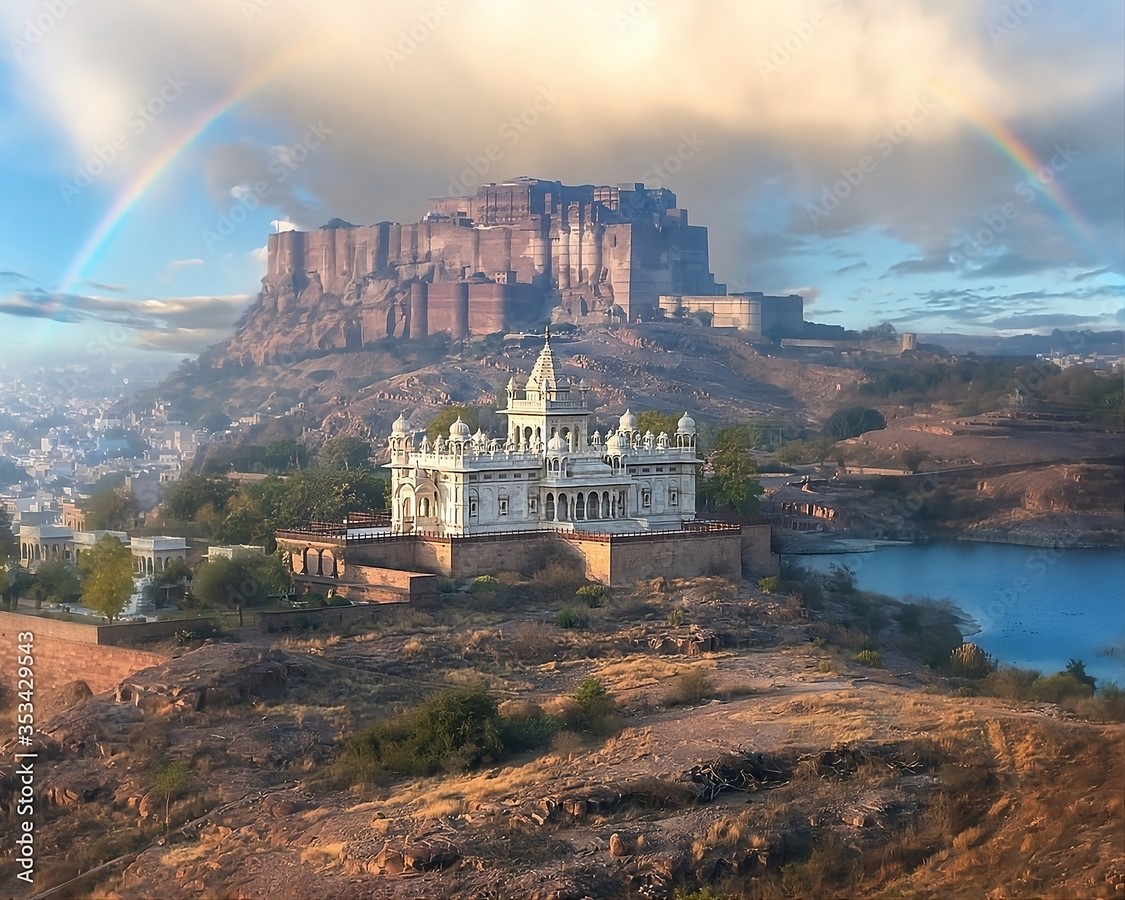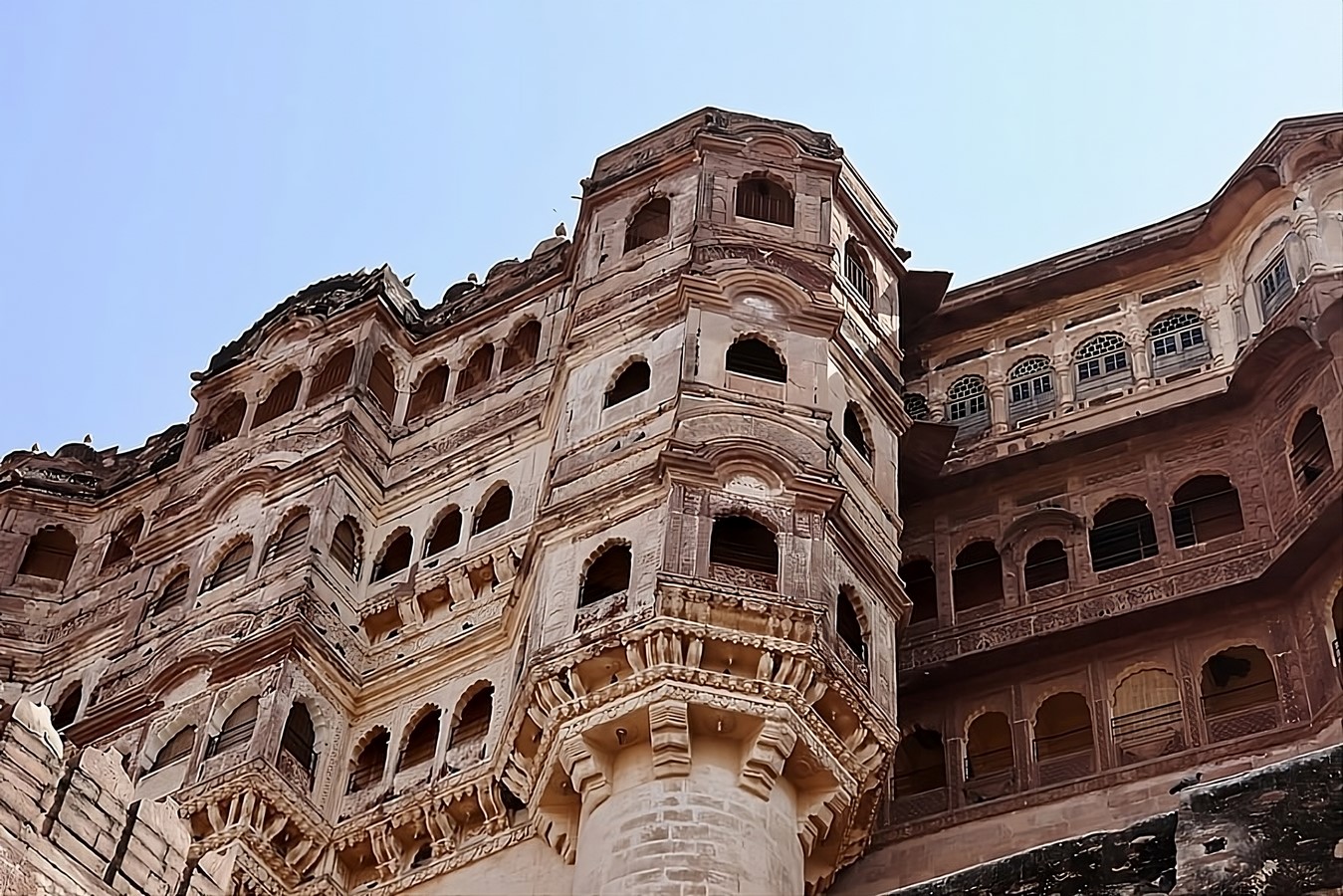Perched majestically on a rocky hill in the city of Jodhpur, Rajasthan, the Mehrangarh Museum stands as a beacon of the region’s cultural heritage and architectural splendor Mehrangarh Museum Trust (n.d). I embark on a captivating journey through time, uncovering the intertwining narratives of art, design, and architecture that define the Mehrangarh Museum’s legacy.

Background and Historical Significance of Mehrangarh Fort
The origins of Mehrangarh Fort can be traced back to the 15th century when Rao Jodha, the founder of Jodhpur, sought to establish a formidable stronghold on the rocky cliffs of Bhaurcheeria (International National Trust Organisation, n.d). The construction of the fort commenced in 1438 and continued over the centuries, with successive rulers contributing to its expansion and embellishment (International National Trust Organisation, n.d). The name “Mehrangarh” is said to be derived from the combination of two Sanskrit words – “Mihir,” meaning sun, and “garh,” meaning fort, symbolizing the Rathore dynasty’s association with the Sun God.
The strategic location of Mehrangarh Fort atop the hill provided a vantage point to oversee the city and protect it from external threats. The fort’s sturdy walls and imposing bastions were designed not only to serve as a military stronghold but also as an architectural marvel that represented the power and prestige of the Marwar rulers (International National Trust Organisation, n.d).
Over the centuries, Mehrangarh Fort witnessed several historical events and battles, each leaving its mark on the fort’s history. It withstood sieges by rival forces and witnessed the rise and fall of empires, all while retaining its significance as a symbol of Marwar’s resilience and cultural identity. (International National Trust Organisation, n.d)
EVOLUTION OF MEHRANGARH FORT INTO A MUSEUM

In the post-independence era, India’s princely states underwent significant changes, and many of the erstwhile royal families began exploring new roles in the country’s evolving socio-political landscape. In 1972, His Highness Maharaja Gaj Singh II, the current head of the Rathore dynasty, took a momentous decision to open a section of the Mehrangarh Fort to the public as a museum (International National Trust Organisation, n.d).
The transformation of Mehrangarh Fort into a museum marked a visionary step towards preserving and showcasing the rich cultural heritage of Marwar to the world. The museum’s establishment aimed to not only conserve the historic artifacts within the fort’s walls but also to share the legacy of Rajasthan’s art, culture, and traditions with the public (International National Trust Organisation, n.d).
With the expertise of architects, historians, and curators, the restoration and adaptive reuse of Mehrangarh Fort were carried out with meticulous attention to maintaining the architectural integrity of the structures while creating spaces suitable for housing a diverse collection of art and artifacts (International National Trust Organisation, n.d).
Today, the Mehrangarh Museum stands as a testament to the harmonious convergence of history, art, and architecture, attracting visitors from across the globe who are captivated by its grandeur and cultural richness (International National Trust Organisation, n.d).
THE ARCHITECTURE OF MEHRANGARH FORT
Mehrangarh Fort, a jewel in the crown of Rajasthan’s architectural heritage, stands proudly atop a rocky hill, dominating the skyline of Jodhpur.
FORT LAYOUT AND DESIGN ELEMENTS
The layout of Mehrangarh Fort exemplifies the meticulous planning and strategic considerations of its founders. The fort’s architecture is a testament to the vision of Rao Jodha, who laid the foundation in 1438 (International National Trust Organisation, n.d). The fort’s structure is arranged in a series of palaces, courtyards, and gardens, each contributing to the fort’s overall grandeur and functionality. The integration of these elements showcases the planning prowess of the architects, ensuring a harmonious combination of living spaces and defensive features.
DEFENSIVE ARCHITECTURE: BASTIONS, WALLS, AND GATEWAYS
Mehrangarh Fort’s defensive architecture is an impressive display of military engineering, designed to withstand sieges and invasions. The fort is enveloped by imposing thick walls that encircle the entire complex, providing formidable protection (International National Trust Organisation, n.d). Strategically placed bastions, equipped with cannons and watchtowers, further fortify the fort’s defenses (International National Trust Organisation, n.d). The most prominent bastion, the Chamunda Mataji Temple, not only served a religious purpose but also offered a strategic vantage point for surveillance and defense (International National Trust Organisation, n.d). The elaborate gateways, such as the Jai Pol and the Fateh Pol, not only served as access points but were also designed with intricate carvings and ornamentation, symbolizing the might and grandeur of the Rathore dynasty (International National Trust Organisation, n.d).
PALACES AND RESIDENCES WITHIN THE FORT
Within the rugged walls of Mehrangarh Fort lie exquisite palaces and residences that reflect the opulence and artistic finesse of the Maharajas of Marwar. The Moti Mahal, or Pearl Palace, showcases breathtaking mirror work and delicate latticework (International National Trust Organisation, n.d). The Phool Mahal, or Flower Palace, boasts intricate floral motifs and gold filigree work (International National Trust Organisation, n.d). These palaces, adorned with elaborately carved jharokhas (balconies) and jali (perforated screens), embody the architectural brilliance of the bygone era, where aesthetics met functionality (International National Trust Organisation, n.d).
COURTYARDS AND GARDENS: AESTHETIC AND FUNCTIONAL ASPECTS
The courtyards and gardens of Mehrangarh Fort are not merely decorative elements but serve important functional and cultural roles. The Mehrangarh Museum showcases the Daulat Khana, a magnificent courtyard where the royal treasury and artifacts are displayed (International National Trust Organisation, n.d). The Chokelao Bagh, a beautiful garden within the fort, provided respite and tranquility to the Maharajas and their court (International National Trust Organisation, n.d). These green spaces were not only aesthetically pleasing but also served as gathering places for important ceremonies and events, reflecting the cultural significance of outdoor spaces in Rajasthani tradition (International National Trust Organisation, n.d).
ARTIFACTS AND ART COLLECTIONS AT MEHRANGARH MUSEUM
Mehrangarh Museum stands as a treasure trove of art and artifacts, offering visitors a fascinating glimpse into the rich cultural heritage of Marwar. Each section of the museum houses a unique collection, revealing the artistic prowess and historical significance of the region. Let us explore the various art collections within the museum:
Arms and Armor: A Glimpse into Marwar Military History
The arms and armor section at Mehrangarh Museum showcases a remarkable collection of weaponry and military artefacts, providing valuable insights into Marwar’s martial history. The exhibit features an array of traditional weapons used by the Rathore warriors, including swords, daggers, shields, and spears (International National Trust Organisation, n.d). Visitors can witness the evolution of these weapons over time, as well as their strategic significance in battles and conflicts. Notable pieces in the collection include intricately decorated daggers and elaborately designed ceremonial armaments, highlighting the craftsmanship and artistic sensibility of the era (International National Trust Organisation, n.d).
Textile and Costumes:Richness of Rajasthani Heritage
The textiles and costumes section at Mehrangarh Museum is a celebration of Rajasthani craftsmanship and artistic excellence. This collection showcases a diverse range of textiles, including exquisitely embroidered fabrics, vibrant turbans, and intricately woven garments (International National Trust Organisation, n.d). The textiles reflect the region’s rich cultural heritage, with each piece telling a story of Rajasthani traditions, customs, and social identities. Visitors are transported back in time as they marvel at the intricate patterns and dazzling colors that have remained integral to Rajasthani life for centuries (International National Trust Organisation, n.d).
The Painting And Murals: The Marwar School of Art
The paintings and murals section of Mehrangarh Museum is a testament to the flourishing artistic culture of Marwar under the patronage of the Rathore dynasty. The collection includes exquisite miniature paintings, frescoes, and murals, primarily from the Marwar School of Art (International National Trust Organisation, n.d). Marwar School of Art emerged as a distinctive style that merged indigenous Rajasthani techniques with influences from Mughal and other artistic traditions. These paintings often depict scenes from epic tales, courtly life, and religious themes, reflecting the socio-cultural milieu of the time (International National Trust Organisation, n.d). The intricate detailing and delicate brushwork in these artworks exemplify the finesse and creativity of Marwar’s skilled artists.
Sculptures and Decorative Arts: Masterpieces of Craftsmanship
The sculpture and decorative arts section of Mehrangarh Museum showcases a captivating array of artistic expressions carved in stone, wood, and metal. The collection includes intricately carved temple sculptures, ornate pillars, and exquisite household artifacts (International National Trust Organisation, n.d). The craftsmanship on display in this section exemplifies the mastery of Marwar’s artisans, who skillfully infused religious symbolism and cultural motifs into their creations. Visitors can appreciate the attention to detail and artistic finesse displayed in each sculpture, further underscoring the reverence for art in the region (International National Trust Organisation, n.d).
Conclusion
The Enduring Legacy of Mehrangarh Museum
The Mehrangarh Museum stands as a remarkable testament to the enduring legacy of Marwar’s rich cultural heritage. The fort’s architecture, with its strategic design and imposing structures, has withstood the test of time, preserving the stories of ancient rulers and their architectural prowess (International National Trust Organisation, n.d). As a museum, it has evolved from a symbol of power into a treasure trove of art and artifacts that provide valuable insights into the region’s history and artistic achievements (International National Trust Organisation, n.d).
Mehrangarh Museum’s art collections, comprising arms and armor, textiles, paintings, sculptures, and decorative arts, offer a glimpse into the multifaceted tapestry of Marwar’s artistic traditions (International National Trust Organisation, n.d). The museum’s role as a custodian of cultural heritage has been instrumental in preserving and promoting Rajasthani art and craftsmanship for future generations (International National Trust Organisation, n.d).
Reflections of Art, Design and Architecture of the Museum

The art, design, and architecture of Mehrangarh Museum intertwine harmoniously, creating an immersive and awe-inspiring experience for visitors. The fort’s architecture, characterized by its defensive features and opulent palaces, exemplifies the fusion of form and function, where aesthetics complemented strategic imperatives (International National Trust Organisation, n.d).
Within the museum’s walls lie art collections that showcase the artistic prowess of Marwar. The armory’s displays of arms and armor reflect the region’s martial heritage and the valor of its warriors (International National Trust Organisation, n.d).The textiles and costumes exhibit the rich colors and intricate weaving techniques that define Rajasthani craftsmanship (International National Trust Organisation, n.d). The paintings and murals representing the Marwar School of Art, evoke a sense of splendor and narrative prowess (International National Trust Organisation, n.d). Meanwhile, the sculptures and decorative arts exemplify the mastery of local artisans, reflecting the cultural richness of the region (International National Trust Organisation, n.d).
The patronage of the Maharajas has left an indelible mark on the museum’s art and design. Their support for artists and artisans resulted in a treasure trove of creativity that resonates with visitors even today (International National Trust Organisation, n.d).
Mehrangarh Museum serves as a living testament to the artistic and architectural heritage of Marwar. Its enduring legacy lies in its ability to bridge the past with the present, offering a window into a bygone era while fostering cultural awareness and appreciation. The museum’s art collections, architectural marvels, and curated exhibits not only enrich the understanding of Rajasthani culture but also inspire contemporary artists and enthusiasts worldwide.
References:
Image 01: Alexeiy. (n.d.). Jodhpur, city scape with a rainbow sky at sunset of Blue city and
Mehrangarh Fort a UNESCO World Heritage Site with Jaswant Thada in the foreground (Photograph). Adobe Stock. https://stock.adobe.com/ng/search?k=%22mehrangarh+fort%22&asset_id=353429543
Image 02: (n.d). India, Jodhpur, historical, building, sky, Mehrangarh Fort Jodhpur, HD
wallpaper (Photograph). Wallpaperflare. https://www.wallpaperflare.com/india-jodhpur-historical-building-sky-mehrangarh-fort-jodhpur-wallpaper-gsdxf
Image 03: (n.d.). Architecture of Mehrangarh (Photograph). Wikimedia Commons.
https://commons.wikimedia.org/wiki/File:Architecture_of_Mehrangarh.jpg
International National Trust Organisation (n.d). Case study: Mehrangarh Fort. Received 29th July
2023 from https://www.into.org/app/uploads/2021/04/Mehrangarh-Fort-case-study-Putting-the-local-into-global-heritage.pdf
Mehrangarh Museum Trust (n.d). About Us. Received 29th July 2023 from
https://www.mehrangarh.org/














